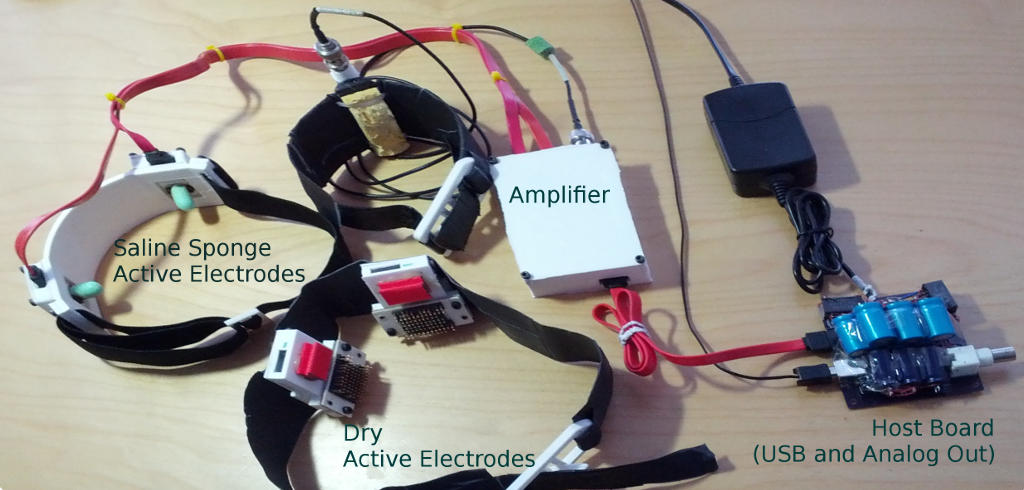Category:BiosignalAmplifier
From HacDC Wiki
Usage
- Connect the USB port to a computer with the BiosignalProcessor software installed.
- Launch the BiosignalProcessor software. Noise floor should be approximately -100dB.
- All sponge electrodes need to be wet, preferably with saline. This includes the reference electrode with a large yellow sponge, and the green sponge electrodes.
- Connect the SATA data cables as shown in the photo. These are actually used as shielded carriers for power and analog signals.
- Plug in the 12V wall wart. This enables the medically isolated RECOM RS-1212D power supplies.
- Noise floor should now be approximately -80dB.
- Cautiously, connect yourself to the Biosignal Amplifier. The BNC connectorized yellow sponge electrode is a reference, and may be connected anywhere on the body, preferably the right leg for electrocardiography, or arm for electroencephalography. The other two electrodes pickup the actual signal, and should be placed near the signal source.
Signal Sources
The pickup electrodes (either the green sponges and headband or dry pin header based electrodes) may be placed at a variety of locations to obtain biosignals in realtime.
- Placing the electrodes hand-to-hand or across the chest should obtain clear, strong electrocardiography (ECG, heartbeat) signals.
- With eyes closed, and pickup electrodes on the back of the head, four out of five participants will show an approximately 10Hz alpha rhythm, usually above -60dB on the chart.
- Across the forehead, electrooculography (EOG, eye movement) signals become dominant.
- Across any major contracted muscle (eg. forearm), random noise will be observed. This is an electromyography (EMG, muscle activity) signal.
- While sleeping, delta rhythms should appear at 90 minute intervals across the parietal (top of the head) and frontal (forehead) lobes. This has yet to be experimentally verified.
Troubleshooting
- The older dry active electrodes, based on gold plated pin headers, are somewhat easier to use than the green saline sponge electrodes. However, they require significant pressure to function properly, particularly for EEG use, which some users find uncomfortable.
- When in doubt, look for an electrocardiograph (ECG heartbeat) signal. Heartbeats are among the most available, strongest, clearest indicators of a working biosignal amplifier.
- The BNC analog output on the host board is designed for connection to an oscilloscope.
- Signal overload will trigger the green LED on the host board to flash.
- HacDC has a BiosignalSimulator on the test cart, which generates synthetic common-mode and differential-mode signals.
Safety
Reasonable safety features have been included. However, there are still some things to be aware of:
- Just 1mA of current for 1ms across the heart is most likely to be fatal. Take no chances.
- DO NOT operate high-power RADIO equipment (ie. our amateur radio station) while connected to the BiosignalAmplifier. High frequency radio transmissions will penetrate the isolation amplifier, which is to say you are an RF ground.
- DO NOT connect to external power in bad weather. Nearby lightning strikes will penetrate the isolation amplifier, and HacDC is not known to have excellent power quality.
- Excessive saline might contact the power supply rails in the active electrodes if the sealant has broken down. If in doubt, check the electrodes for voltage with a multimeter before using. Anything above 0.6V indicates a fault has occurred.
- No claim of liability is made by anyone. Your accident is your accident. Use common sense. If you don't understand the safety features and limitations, don't use this circuit.

